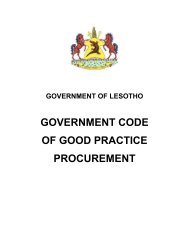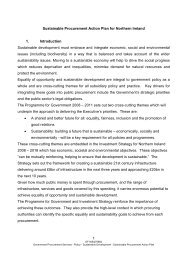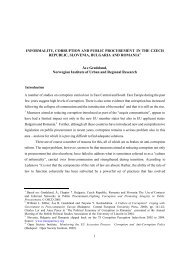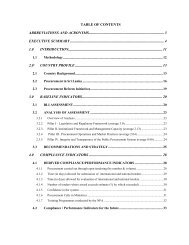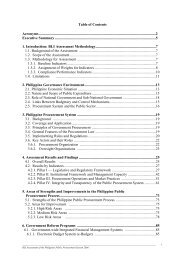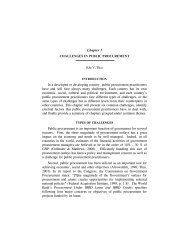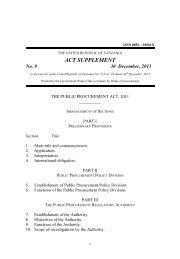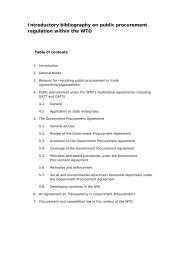Compendium of Country Examples and Lessons Learned from ...
Compendium of Country Examples and Lessons Learned from ...
Compendium of Country Examples and Lessons Learned from ...
Create successful ePaper yourself
Turn your PDF publications into a flip-book with our unique Google optimized e-Paper software.
Implementing a Procurement AssessmentThe following section provides methodological background information <strong>and</strong> shares experiences onusing the indicator system.“Baseline indicators” presents the key elements <strong>of</strong> the Methodology <strong>and</strong> discusses some practicalissues such as arriving at the “right score” <strong>and</strong> the importance <strong>of</strong> documentary evidence.“Performance/compliance indicators” introduces the Methodology <strong>and</strong> summarises experiencesfocusing on sampling, data collection <strong>and</strong> interpreting the results.The assessment cycle is completed with sections entitled Validation <strong>and</strong> Assessment Report, duringwhich high-level government <strong>of</strong>ficials, development partners <strong>and</strong> stakeholders are included forvalidation <strong>and</strong> reporting purposes.Part I:Baseline indicatorsAs indicated earlier, the Methodology follows a two-step approach: Part I covers the Baselineindicators (BLIs) that deal with the formal <strong>and</strong> functional features <strong>of</strong> the existing system. Part IIcovers the compliance/performance indicators (CPIs) that deal with monitoring performance data todetermine the level <strong>of</strong> compliance with the formal system. The two parts are designed to be appliedjointly or separately depending on the intended purpose <strong>and</strong> scope <strong>of</strong> the assessment. Theunderst<strong>and</strong>ing is that the assessment will provide a basis upon which a country can formulate acapacity development plan to improve its procurement system as well as to establish a baseline againstwhich future progress can be measured. It was agreed with the JV on Monitoring the Paris Declarationthat the procurement baseline indicators would be used to monitor the qualitative procurement target<strong>of</strong> the Paris Declaration (Target 2b). 12The Methodology provides 4 pillars organised around 12 indicators <strong>and</strong> 54 sub-indicators with definedscoring criteria. The scoring system ranges <strong>from</strong> 3 to 0 for each baseline sub-indicator with theexception <strong>of</strong> 2 sub-indicators, which are pass/fail criteria (sub-indicator 4d <strong>and</strong> 10e).The Methodology includes a User‟s Guide, which is a “must read” when preparing for an assessment.Some key elements shall be highlighted as follows: 131213Indicator 2, Reliable country systems: number <strong>of</strong> partner countries that have procurement <strong>and</strong> publicfinancial management systems that either a) adhere to broadly accepted good practices or b) have areform programme in place to achieve these. Target for 2(b) Procurement: one-third <strong>of</strong> partnercountries move up at least one measure (i.e. <strong>from</strong> D to C, C to B or B to A on the four-point scaleused to assess performance for this indicator).Methodology for Assessment <strong>of</strong> National Procurement Systems,www.oecd.org/dac/effectiveness/procurement.COMPENDIUM OF COUNTRY EXAMPLES AND LESSONS LEARNED […] - OECD 2008 23



